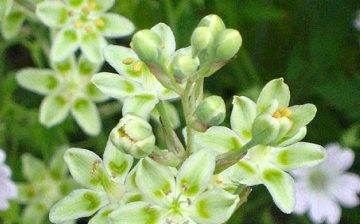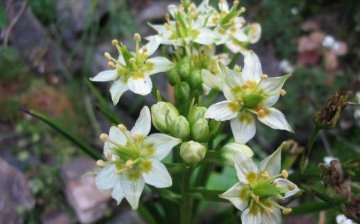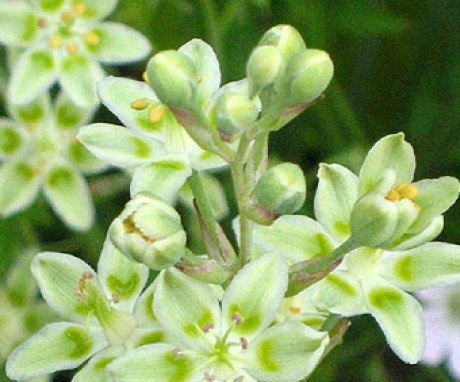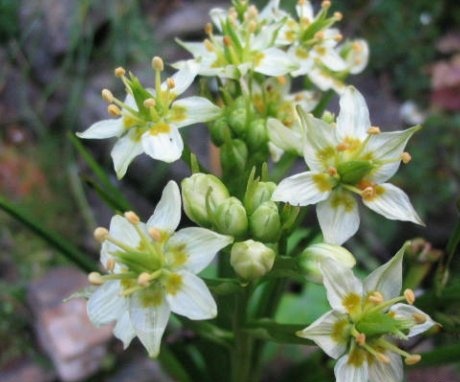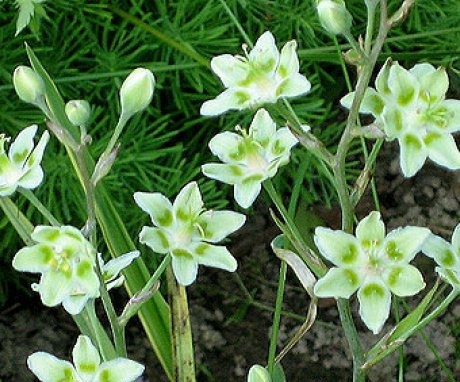Zigadenus: rules for growing, care and plant features
Zygadenus is rarely found in our gardens. This is not due to the difficulties of cultivation or the lack of high decorative qualities, but to its low popularity.
Content:
Zygadenus: features of the genus
Zygadenus or Anticlea came to our country from North America, some species originated in Siberia and Japan. In total, there are about 25 species in the genus. These are bulbous plants with a maximum height of 1 meter.
The genus Zygadenus belongs to the Liliaceae family.
The roots of the plant are tough, resilient, there are several large bulbs, each with a coating similar to a film. Zygadenus leaves are linear, covered with a bluish bloom. The leaves are long, reaching 30 cm in length and 1.5 cm in width. The flowering period lasts all summer, from June to the end of August. The flowers are delicate and neat, light shades: yellow, lemon, white. The petals are thin, connected at the base.
The flowers are collected in large inflorescences, which outwardly resemble lilac inflorescences. In home cultivation, zygadenus is not popular, it began to appear in gardens only in recent years. It is planted in rockeries, flower beds, make paths from a flower and decorate with stones and boulders. Zygadenus is poisonous plant... I use some types in folk medicine.
Two species that are grown in culture: Siberian and graceful.
Siberian zygadenus:
- It has an erect, thin stem, maximum height 80 cm.
- The leaves are long, narrow, located closer to the base.
- The flowers are white with a green tint, gathered in a panicle inflorescence, the fruits are capsules.
- The flowering period lasts from June to August.
Siberian zygadenus grows on river banks, on forest slopes and coniferous forests... The plant is poisonous, since the exact composition has not been studied enough, then the plant must be used extremely carefully. In the Siberian zygadenus, there are strong alkaloids that act on the body like veratrin.
This type of zagidenus can be used for decoctions to relieve pain in neuralgia and rheumatism and as an antiparasitic agent. The tincture is used to fight head and pubic lice. Now the plant is used in agriculture for pest and insect control.
Zygadenus graceful (elegant):
- In nature, it is distributed from Alaska to North America.
- The height can range from 15 to 90 cm.
- The bulbs are elongated, narrow, connected to a common rhizome.
- The leaves are also found on the bottom of the stem.
- The leaves are reduced, narrow, tough, have a large number of veins, the color is green with a bluish tint.
- The flowers are fragrant, white-green or yellow, collected in a raceme inflorescence.
- The flowering period lasts from July and lasts several weeks, withstands severe winters.
Both species are similar in appearance, although they have their own characteristics.
Growing zygadenus at home
Zigadenus is an unpretentious plant. It is easy to grow in the garden even for a beginner.
Primary requirements:
- Semi-shaded area.
- Abundant watering.
- Fertile soil.
- Lack of transfers.
Zygadenus can thrive both in sunny areas and in the shade of trees. The optimal arrangement of the flower in slightly shaded areas.If the leaves of the zygadenus are exposed to direct sunlight for a long time, this will not have a destructive effect. If the plant is in a dark place, then it will grow a little slower.
Zigadenus tolerates winter well, therefore it does not require shelter, it can remain in the open field.
Zigadenus prefers fertile soil, it must be rich in nutrients, trace elements, and drainage must be well organized. To maintain the same level of nutrients in the ground, fertilizing is carried out with balanced fertilizers.
The soil is suitable loamy or sandy loam. The acidity of the soil is neutral. Zygadenus is resistant to parasites and diseases. The plant loves a large amount of moisture, so you need to remember to water it in a timely manner, especially in dry weather. The soil must be constantly moist. Drying of the soil is possible only occasionally, but no more than 5 days. If the plant receives excess moisture, then this factor will not affect growth and development in any way.
When planting a zygadenus, you need to carefully choose a place, since the flower is difficult to tolerate transplants. For a long time after the change of location, the plant will grow slower and bloom less abundantly or will not bloom at all.
Reproduction takes place in two ways: vegetatively and by seeds.
Like many other plants, propagate by seeds the flower will be obtained only by experienced gardeners. This is a time consuming and time consuming process that requires careful adherence to environmental conditions.
Plant propagation by seeds:
- Before the plant is propagated by seeds, their stratification is not required.
- The first shoots will not sprout soon, their development will be slow, during this period they are provided with maximum rest.
- When transplanting, the seedling may die or further slow down its growth.
- The first year, young seedlings should overwinter at home in a cool room.
- If there is a need to take them outside, then the box itself is placed in the ground, then it is mulched and covered with leaves in a layer of 5 cm.
- Already in the spring, plants can be planted in a permanent place in the ground.
If reproduction is planned by dividing the bush, then this is done either at the beginning of the period of active growth, or immediately after the end of flowering.
Zygadenus does not need special conditions, but the requirements that he makes must be met unquestioningly. Then he will reward the owner with beautiful delicate flowers.
More information can be found in the video.




